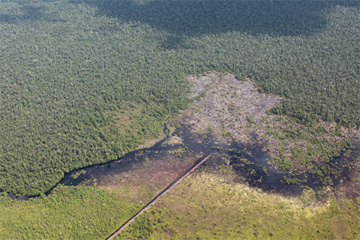Peatlands destruction for oil palm a 'monumental mistake' for Indonesia
Indonesia’s decision earlier this year to allow conversion of up to 2 million hectares of peatlands for oil palm plantations is “a monumental mistake” for the country’s long-term economic prosperity and sustainability, argues an editorial published in the June issue of Frontiers in Ecology and the Environment. Lian Pin Koh of ETH Zurich, Corey J.A. Bradshaw of the University of Adelaide, and I cite five reasons why the move is a counterproductive one for Indonesia. First, draining of peatlands to the depth of 60-80 cm recommended for oil palm cultivation will trigger an immense release of carbon into the atmosphere, exacerbating, rather than mitigating, global warming. While burning releases enormous amounts of carbon dioxide, merely draining peatlands also contributes to global warming — upon exposure to air, peat rapidly oxidizes, decomposes, and releases carbon dioxide. A study led by Dr. Susan Page University of Leicester found that producing one ton of palm oil on peatland generates 15 to 70 tons of CO2 over 25 years as a result of forest conversion, peat decomposition and emission from fires associated with land clearance. Second, peatlands are formed by hundreds to thousands of years of accumulation of dead vegetation. Thus recovery after degradation and destruction will take generations. In the meantime the services afforded by peatlands, including locking up vast amounts of carbon and acting as a “sponge” to reduce the incidence of flooding, will be reduced or non-existent. Third, swamp forests growing on peatlands are highly biodiverse ecosystems supporting a wide range of plant and animal life, including endangered orangutans. Conversion to oil palm will drastically reduce species richness (recent research has shown that conversion of primary rainforest to an oil palm plantation results in a loss of more than 80 percent of species). Fourth, degradation of peatlands will increase the incidence of “haze” that results from peat fires. Past haze events — especially during the el Niñe of 1997-1998 — show that peat fires carry substantial economic, health, and political costs. …
